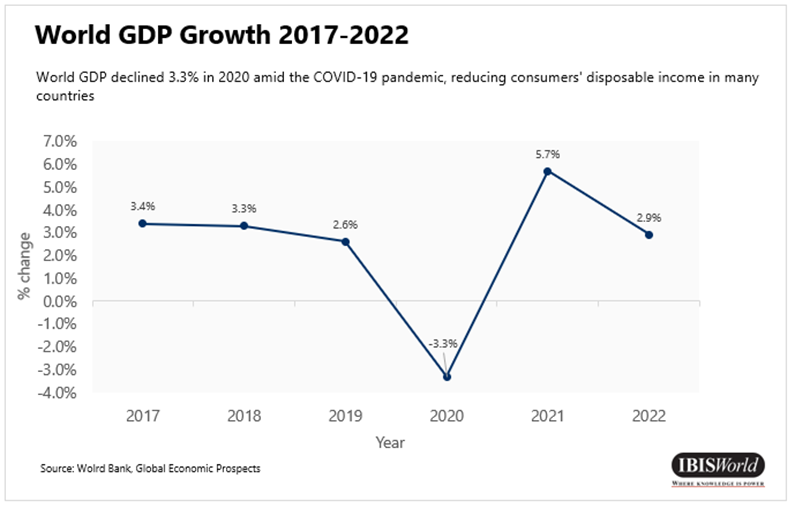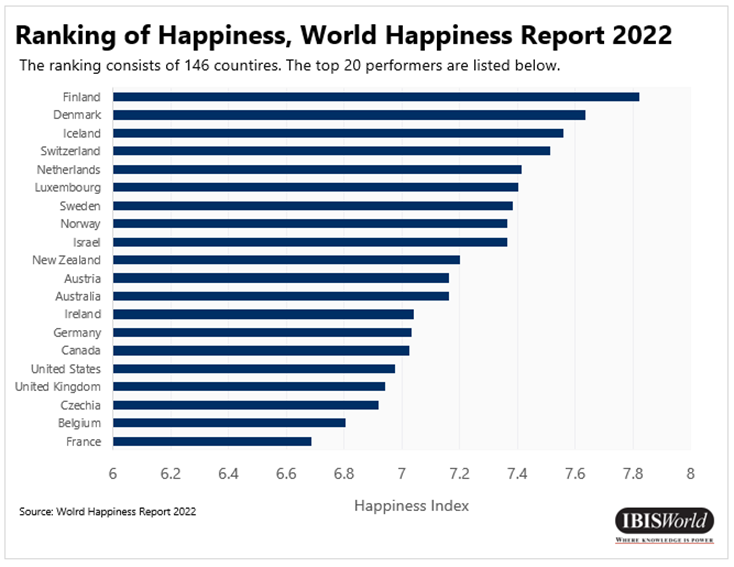Every year, the United Nations Sustainable Development Solutions Network publishes the World Happiness Report (WHR), which ranks countries by how their populations feel.
The ranking considers various factors such as GDP per capita, social support, healthy life expectancy, freedom to make life choices, generosity and perception of corruption. Happiness is crucial for economic growth as it makes people more productive at work.
The most recent edition of the World Happiness Report, WHR 2022, sheds light on how people’s life satisfaction has changed during the pandemic.
Why has income become less important amid COVID-19?
The WHR measures income as a GDP per capita in terms of purchasing power. Historically, income has been the single-largest contributing factor to happiness, accounting for one-third of the total.
In 2020, world GDP per capita fell amid the COVID-19 (coronavirus) pandemic, declining 3.6% that year alone, according to IBISWorld estimates. This decrease had a negative effect on happiness worldwide.

However, the pandemic has reduced the effect of income on life satisfaction while increasing the benefits of having someone to count on during uncertain times. Thus, even though income declined, this decline had a smaller effect on life satisfaction than previously expected.
Moreover, in the United States specifically, pandemic-related stimulus packages boosted per capita disposable income, offsetting income-related negative effects associated with the virus.
What social support exists?
Social support is measured as the national average to the question, “If you were in trouble, do you have relatives or friends you can count on to help you whenever you need them, or not?”
Much of the effect of social support is channeled through its influence on positive emotions, which in turn increase life satisfaction. Data from the World Happiness Report 2013 demonstrates that the happiness consequences of the financial crisis of 2007-08 were lower in communities with stronger social support and greater levels of mutual trust.
Social support tends to be the highest in smaller and more homogeneous countries such as Finland and Norway. However, the United States still ranks high on this list, or 25th out of 146 countries. During the coronavirus pandemic in 2020, the role of social support increased worldwide, including its effect on life satisfaction in the United States.

How has healthy life expectancy been affected?
The same WHR 2022 report also estimates the effect of healthy life expectancy (HALE) at birth, which is similar to life expectancy, but it also considers the time spent when a person is sick.
Globally, HALE increased nearly 9.3% between 2000 and 2019, reaching 63.7 years in 2019, according to the World Health Organization (latest data available).
Countries with the highest health indicators are located primarily in East Asia and Western Europe. In the United States, HALE declined 0.5% between 2000 and 2019, having a negative effect on life satisfaction.
The coronavirus pandemic further reduced healthy life expectancy in the United States as the number of both sick days and deaths increased.
What now?
The WHR 2022 shows that the average life evaluations globally have remained resilient during the pandemic. While life satisfaction has fallen for the young, it increased for those older than 60, but with little overall change.
The pandemic resulted in increased levels of stress and worry; however, it also increased benevolence, contributing to higher life evaluations of givers, receivers, and observers.
Moving forward, the prospects of happiness will depend on various factors, including the future course of the pandemic and the scale of military conflict.
Check out IBISWorld’s Industry Insider to learn more about other effects of the coronavirus pandemic on other world economies.
Source from Ibisworld
The information set forth above is provided by Ibisworld independently of Chovm.com. Chovm.com makes no representation and warranties as to the quality and reliability of the seller and products.




